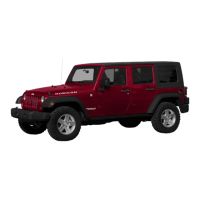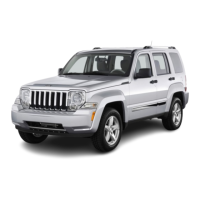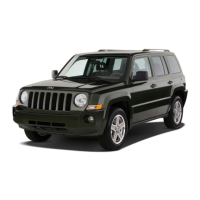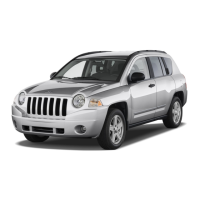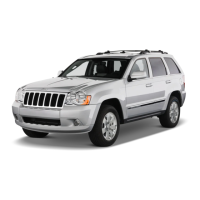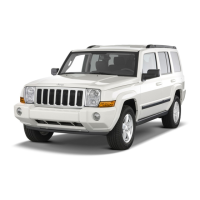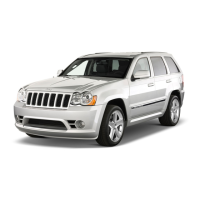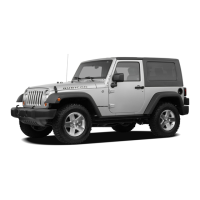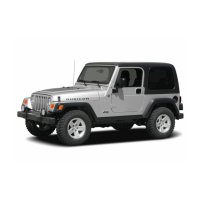
Do you have a question about the Jeep 2009 Wrangler and is the answer not in the manual?
| Brand | Jeep |
|---|---|
| Model | 2009 Wrangler |
| Category | Automobile |
| Language | English |
Details about the specialized utility vehicle, its capabilities, and handling differences from passenger cars.
Warns about the higher rollover rate of utility vehicles due to higher ground clearance and center of gravity.
Guidance on how to navigate the owner's manual using the table of contents and index.
Highlights warnings about operating procedures that could cause accidents or injury, and cautions about vehicle damage.
Explains where to find the VIN and the importance of the Automobile Information Disclosure Label.
Warns that modifications can affect roadworthiness and safety, potentially leading to serious injury or death.
Information regarding vehicle keys, key code numbers, and obtaining replacements from the dealer.
Instructions for removing the ignition key from the switch for both automatic and manual transmissions.
Explanation of the passive steering wheel lock system and how it engages without the ignition key.
Details on the Sentry Key Immobilizer System that prevents unauthorized vehicle operation by disabling the engine.
Procedure for programming new Sentry Keys to the system using existing valid keys.
Information on how the vehicle security alarm system monitors doors, gate, and ignition for unauthorized operation.
Description of the system allowing remote locking/unlocking of doors and swing gate using a transmitter.
Instructions on using the remote keyless entry transmitter to unlock vehicle doors and the swing gate.
Instructions on using the remote keyless entry transmitter to lock all doors and the swing gate.
How to activate and deactivate the panic alarm feature using the remote keyless entry transmitter.
Procedure for programming additional Remote Keyless Entry transmitters for the vehicle.
Instructions on how to replace the battery in the RKE transmitter, including precautions.
Details on the remote starting system for automatic transmission models, allowing vehicle start from a distance.
Information on door removal and installation, including upper half door window procedures.
Explanation of manual and power door lock systems, including automatic unlock/lock features.
Details on power window operation, including window lockout and auto-down features.
Information on the rear swing gate operation and related warning messages displayed.
Overview of restraint systems including seat belts and airbags for driver and passengers.
Instructions on operating lap/shoulder belts, including retractor locking and proper usage.
Details on the lock-out feature for rear center belts, ensuring seatback latching.
Guidance on adjusting the shoulder belt anchorage for optimal comfort and safety.
Explanation of the pretensioning device in seat belts designed to remove slack during a collision.
Information on the BeltAlert system that reminds the driver to buckle up.
Recommendations for pregnant women on proper seat belt usage to ensure safety.
Information on using seat belt extenders when the standard belt is too short for proper fit.
Details about the SRS, including driver and front passenger airbags and knee bolsters.
Guidelines and warnings for using child restraints, including rearward-facing and forward-facing seats.
Overview of the vehicle's instrument panel layout and major control components.
Detailed explanation of each indicator light, gauge, and warning light in the instrument cluster.
Information on the compass and trip computer features, including control buttons and display functions.
Operating instructions for the AM/FM stereo radio with CD player and MP3/WMA AUX Jack.
Details on the multimedia system, including radio, CD/DVD player, USB port, and touch screen.
Explanation of manual heater and air conditioning controls, including mode selection and blower operation.
Basic steps for starting the vehicle, including manual and automatic transmission procedures.
Information on the engine block heater for cold weather starting and its proper use.
Guidance on manual transmission operation, including shifting, downshifting, and reverse shifting.
Details on automatic transmission operation, including brake/transmission interlock system and manual override.
Explanation of four-wheel drive systems (Command-Trac/Rock-Trac), including operating instructions and precautions.
Information on the Trac-Lok rear axle feature, providing constant driving force to both rear wheels.
Details on the Axle Lock feature for Rubicon models, including activation conditions.
Explanation of the electronic sway bar disconnect system for enhanced off-road suspension travel.
Advice for driving on paved roads, emphasizing vehicle stability and handling characteristics.
Guidance for off-road driving, including terrain types, obstacles, and vehicle control techniques.
Information on the standard power steering system, its response, and troubleshooting for interruptions.
Instructions on how to set and release the parking brake, with warnings about its proper use.
Explanation of the ABS system designed to aid driver control under adverse braking conditions.
Overview of the advanced electronic brake control system, including ABS, TCS, BAS, HSA, ERM, ESP, and TSC.
Information on tire markings, size designation, service description, and load/pressure ratings.
Essential information on tire pressure, economy, ride comfort, and vehicle stability.
Recommendations for maintaining correct tire inflation pressure for high-speed driving under load.
Warnings and advice regarding the use and repair of radial-ply tires.
Warnings about the dangers of spinning tires in stuck conditions and potential tire damage.
Explanation of tread wear indicators and factors affecting tire service life.
Recommendations for selecting and replacing tires to maintain vehicle safety, handling, and performance.
Information on the consequences of poor suspension alignment and the importance of wheel alignment.
Guidelines for installing and using tire chains, including model compatibility and speed limitations.
Advice on tire rotation to ensure even wear and maintain traction, including suggested methods.
Recommendations for using unleaded gasoline with 87 octane and guidelines on reformulated gasoline.
Information on the use of oxygenated gasoline blends, including cautions regarding methanol.
Details on E-85 usage in non-flex fuel vehicles and potential symptoms of incorrect fueling.
Guidelines for maintaining vehicle performance, including warnings about leaded gasoline and additives.
Precautions to prevent carbon monoxide poisoning from exhaust gases.
Instructions on adding fuel, including the location and proper use of the fuel filler cap.
Information on the 'gASCAP' message and how to resolve potential fuel filler cap issues.
Guidance on vehicle loading, including certification labels and weight ratings.
Safety tips and information on towing limits, including common definitions and requirements.
Definitions of terms related to trailer towing, such as GVWR, GTW, GCWR, and GAWR.
Industry standards for trailer hitch classes and maximum towing weights.
Chart detailing maximum trailer weight ratings based on engine, axle, model, and drivetrain.
Guidelines on loading trailers for proper weight distribution and avoiding trailer sway.
Recommendations for proper break-in of drivetrain components when towing.
Information on trailer brake systems, including requirements for electronically actuated brakes.
Guidelines for trailer lights and wiring, including the use of a factory-approved 4-pin harness.
General towing tips for both manual and automatic transmissions, including O/D Off and speed control.
Specific procedures and cautions for recreational towing, including 2WD and 4WD models.
Instructions on operating the hazard warning flasher for emergency signaling when the vehicle is disabled.
Actions to take to reduce potential overheating, such as slowing down or shifting to neutral.
Safety warnings and procedures for jacking the vehicle and changing a tire.
Step-by-step procedure for jump starting a vehicle with a discharged battery, including safety warnings.
Information on the location and proper use of emergency tow hooks for off-road rescue.
Recommended methods for towing a disabled vehicle, emphasizing safety and preventing transmission damage.
Diagram and identification of major components located in the engine compartment.
Explanation of the OBD II system, its function, and the Malfunction Indicator Light.
Information on emissions control system checks and the OBD II system readiness for testing.
Recommendation to use genuine MOPAR parts for maintenance and repairs to ensure performance and warranty.
Importance of using authorized dealer service for knowledge, tools, and proper repair procedures.
Overview of required maintenance services, including engine oil checks and filter replacements.
Guidance on checking engine oil level, changing oil, and selecting the correct engine oil viscosity.
Information on the air cleaner filter, its protective function, and selection of replacement filters.
Details about the maintenance-free battery and warnings regarding battery post components.
Recommendations for air conditioner service, including condenser cleaning and performance testing.
Instructions for lubricating body pivot points, locks, and hinges for proper operation and protection.
Tips for cleaning wiper blades and windshield, and avoiding damage from dry wiping.
Information on the washer fluid reservoir, checking fluid levels, and preventing freeze-up.
Importance of a maintained exhaust system for carbon monoxide protection and inspection guidelines.
Warnings and procedures for checking engine coolant, including pressure cap safety and fluid checks.
Importance of inspecting brake system components periodically for performance and safety.
Cross-reference to ABS information within the manual.
Cross-reference to fuel adding procedures.
Cross-reference to washer fluid adding instructions.
Cross-reference for engine air cleaner filter information.
Cross-reference for air conditioner maintenance procedures.
Cross-reference for air conditioning system operation.
Cross-reference for air conditioning control operations.
Cross-reference for operating tips related to air conditioning.
Cross-reference for air conditioning refrigerant information.
Cross-reference for air conditioning system details.
Cross-reference for air filter information.
Cross-reference for tire air pressure information.
Cross-reference for airbag system information.
Cross-reference for airbag deployment details.
Cross-reference for airbag indicator light information.
Cross-reference for airbag system maintenance.
Cross-reference for side airbag information.
Cross-reference for alarm indicator light.
Cross-reference for security alarm system details.
Cross-reference for wheel alignment and balance information.
Cross-reference for vehicle alterations and modifications.
Cross-reference for satellite radio antenna information.
Cross-reference for engine coolant (antifreeze) information.
Cross-reference to ABS system details.
Cross-reference for anti-lock warning light.
Cross-reference for vehicle appearance care.
Cross-reference for arming the theft system.
Cross-reference for auto down power window feature.
Cross-reference for automatic transmission operation and maintenance.
Cross-reference for automatic transmission fluid and filter change intervals.
Cross-reference for automatic transmission fluid level check.
Cross-reference for recommended transmission fluid type.
Cross-reference for automatic transmission gear ranges.
Cross-reference for automatic transmission shifting procedures.
Cross-reference for automatic transmission fluid additives.
Cross-reference for torque converter information.
Cross-reference for auxiliary electrical outlet information.
Cross-reference for auxiliary power outlet details.
Tips for preparing for service appointments and making reasonable requests.
Information on contacting manufacturer customer centers and authorized dealers for assistance.
Contact information for hearing or speech impaired customers.
Information about purchased service contracts and their relation to the manufacturer's warranty.
Reference to the Warranty Information Booklet for terms and provisions applicable to U.S. vehicles.
Information on the availability of Mopar fluids, lubricants, parts, and accessories from authorized dealers.
Guidance on reporting safety defects to NHTSA and the manufacturer.
Information on how to order service manuals and other publications.
Explanation of DOT uniform tire quality grades: Treadwear, Traction, and Temperature.
Description of tire traction grades (AA, A, B, C) representing the ability to stop on wet pavement.
Explanation of tire temperature grades (A, B, C) representing heat resistance and dissipation.

